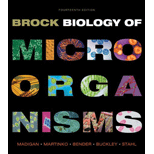
Brock Biology of Microorganisms Plus MasteringMicrobiology with eText -- Access Card Package (14th Edition)
14th Edition
ISBN: 9780321897077
Author: MADIGAN
Publisher: PEARSON
expand_more
expand_more
format_list_bulleted
Concept explainers
Textbook Question
Chapter 3.1, Problem 2MQ
Which two classes of macromolecules contain most of a cell's nitrogen?
Expert Solution & Answer
Want to see the full answer?
Check out a sample textbook solution
Students have asked these similar questions
Which biomolecules contain nitrogen?
What are the basic roles of carbohydrates,fats, proteins, and nucleic acids in the cell?
Which are four main families of these small Biomolecules ?
Chapter 3 Solutions
Brock Biology of Microorganisms Plus MasteringMicrobiology with eText -- Access Card Package (14th Edition)
Ch. 3.1 - Which four chemical elements make up the bulk of a...Ch. 3.1 - Which two classes of macromolecules contain most...Ch. 3.1 - Prob. 3MQCh. 3.2 - Why would a complex culture medium for Leuconostoc...Ch. 3.2 - In which medium shown in Table 5.1, defined or...Ch. 3.2 - What is meant by the word sterile? Why is aseptic...Ch. 3.3 - Prob. 1MQCh. 3.3 - Prob. 2MQCh. 3.4 - What is free energy?Ch. 3.4 - Prob. 2MQ
Ch. 3.4 - Using Table 3.2, calculate G0 for the reaction...Ch. 3.5 - Prob. 1MQCh. 3.5 - Prob. 2MQCh. 3.5 - Prob. 3MQCh. 3.6 - Prob. 1MQCh. 3.6 - Prob. 2MQCh. 3.6 - Prob. 3MQCh. 3.7 - How much free energy is released when ATP is...Ch. 3.7 - Prob. 2MQCh. 3.7 - Prob. 3MQCh. 3.8 - Which reactions in glycolysis are redox steps?Ch. 3.8 - Prob. 2MQCh. 3.8 - Prob. 3MQCh. 3.9 - Prob. 1MQCh. 3.9 - Prob. 2MQCh. 3.10 - Prob. 1MQCh. 3.10 - Which electron carriers described in this section...Ch. 3.11 - How do electron transport reactions generate the...Ch. 3.11 - Prob. 2MQCh. 3.11 - What structure in the cell links the proton motive...Ch. 3.12 - Prob. 1MQCh. 3.12 - What two major roles do the citric acid cycle and...Ch. 3.12 - Why is the glyoxylate cycle necessary for growth...Ch. 3.13 - Prob. 1MQCh. 3.13 - Prob. 2MQCh. 3.13 - Prob. 3MQCh. 3.14 - What form of activated glucose is used in the...Ch. 3.14 - Prob. 2MQCh. 3.14 - What functions does the pentose phosphate pathway...Ch. 3.15 - Prob. 1MQCh. 3.15 - List the steps required for the cell to...Ch. 3.15 - Which nitrogen bases are purines and which are...Ch. 3.16 - Prob. 1MQCh. 3.16 - Prob. 2MQCh. 3.17 - Prob. 1MQCh. 3.17 - Prob. 2MQCh. 3.17 - Prob. 3MQCh. 3 - Prob. 1RQCh. 3 - Prob. 2RQCh. 3 - What is aseptic technique and why is it necessary?...Ch. 3 - Prob. 4RQCh. 3 - REVIEW QUESTIONS
5. Describe how you would...Ch. 3 - Prob. 6RQCh. 3 - Why are enzymes needed by the cell? (Section 3.5)
Ch. 3 - Prob. 8RQCh. 3 - 9. What is the reduction potential of the...Ch. 3 - Prob. 10RQCh. 3 - How is ATP made in fermentation and in...Ch. 3 - Prob. 12RQCh. 3 - MINIQUIZ
13. Besides lactic acid and ethanol, list...Ch. 3 - List some of the key electron carriers found in...Ch. 3 - What is meant by proton motive force and how is it...Ch. 3 - Prob. 16RQCh. 3 - MINIQUIZ
17. How much more ATP is possible in...Ch. 3 - Prob. 18RQCh. 3 - MINIQUIZ
19. What is the major difference between...Ch. 3 - Prob. 20RQCh. 3 - Describe the process by which a fatty acid such as...Ch. 3 - Prob. 22RQCh. 3 - Prob. 1AQCh. 3 - Application Questions
2. Desulfovibrio can grow...Ch. 3 - Using the data of Figure 3.10, predict the...Ch. 3 - Prob. 4AQ
Knowledge Booster
Learn more about
Need a deep-dive on the concept behind this application? Look no further. Learn more about this topic, biology and related others by exploring similar questions and additional content below.Similar questions
- When simple monosaccharides are linked together into larger oligosaccharides by the process of dehydration synthesis, what other molecule is created?arrow_forwardHow does the metabolism of glucose and glutamine support the synthesis of nucleotides, lipids, and amino acids?arrow_forwardwhat is macrosystematics?arrow_forward
arrow_back_ios
SEE MORE QUESTIONS
arrow_forward_ios
Recommended textbooks for you
 Human Biology (MindTap Course List)BiologyISBN:9781305112100Author:Cecie Starr, Beverly McMillanPublisher:Cengage Learning
Human Biology (MindTap Course List)BiologyISBN:9781305112100Author:Cecie Starr, Beverly McMillanPublisher:Cengage Learning

Human Biology (MindTap Course List)
Biology
ISBN:9781305112100
Author:Cecie Starr, Beverly McMillan
Publisher:Cengage Learning
Macromolecules | Classes and Functions; Author: 2 Minute Classroom;https://www.youtube.com/watch?v=V5hhrDFo8Vk;License: Standard youtube license